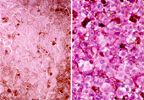Immunosuppression Due to Lymphoma, Organ Transplant Increases Risk of Melanoma
A new review of the literature shows that melanoma is substantially more common in immunosuppressed patients, including those with prior solid organ transplant and individuals with lymphoma.
A new review of the literature shows that melanoma is substantially more common in immunosuppressed patients, including those with prior solid organ transplants and individuals with lymphoma. The analysis was published in the October issue of Mayo Clinic Proceedings.

A new study finds an increased risk in melanoma in lymphoma and organ transplant patients. Above: Slide from a 53-year-old woman with metastatic melanoma to multiple subcutaneous sites and retroperitoneum. She was treated with tumor infiltrating lymphocytes transduced with the gene for tumor necrosis factor.
“Melanoma is an immunogenic tumor,” wrote researchers led by Jerry D. Brewer, MD, of the Mayo Clinic in Rochester, Minnesota. “This area of research proves challenging because of the intricacies of melanoma, as well as the heterogeneity and complexity that comprise immunosuppression.” In melanoma, regulatory CD4+CD25+ T cells secrete cytokines that suppress immune activation, lessening the antitumor immune response.
In a review of the literature on how immunosuppression affects melanoma, the authors analyzed a number of studies that were generally large, with at least 1000 patients for organ transplant recipients and at least 500 patients in lymphoma studies.
In the organ transplant studies, most data suggest an increased risk of melanoma following transplant. Though some studies did not find significant impact on melanoma risk, those that did ranged from 2.1- to 8-fold higher risk of melanoma following a solid organ transplant. The mean time for melanoma development in patients who undergo a transplant is 61 months, with a range in various studies from 40 to 132 months. The available data also suggest that these patients have poorer survival outcomes than melanoma patients who did not undergo a transplant.
The other main category of immunosuppressed patients who are at increased risk of melanoma are those with lymphoma. Unlike the immunosuppression induced for transplant recipients, “lymphoproliferative malignant neoplasms are associated with an innate and inherent immunosuppression characteristic of the disease itself that can be further exacerbated with medications,” the authors wrote.
Studies of lymphoma patients have yielded varying ranges of increased melanoma risk, with one study yielding as high as a 16-fold increased risk. Most are lower than that, though patients with chronic lymphocytic leukemia (CLL) have been found to have as much as an 8-fold increased risk of skin cancers; other studies have shown ranges of 2.8- to 3.2-fold greater melanoma risk. Again, the disease course in melanoma patients who previously had lymphoma indicates poorer survival than other patients, with an overall survival rate that is 2.6 times worse in CLL patients in particular.
The authors gave recommendations based upon the available data on immunosuppressed patients. The key recommendation is vigilance and screening, and patients and physicians should be especially suspicious with regard to recurrence.
“How you catch melanoma earlier is to be very aware of your skin,” Dr. Brewer said in a press release. “These patients with immunosuppression should be looking themselves over head to toe once a month, they should be seeing a dermatologist once or twice a year, and if they have a lot of other risk factors, maybe more often than that.”